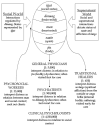Navigating diagnoses: understanding mind-body relations, mental health, and stigma in Nepal
- PMID: 18784989
- PMCID: PMC3869091
- DOI: 10.1007/s11013-008-9110-6
Navigating diagnoses: understanding mind-body relations, mental health, and stigma in Nepal
Abstract
Anthropologists and psychiatrists traditionally have used the salience of a mind-body dichotomy to distinguish Western from non-Western ethnopsychologies. However, despite claims of mind-body holism in non-Western cultures, mind-body divisions are prominent in non-Western groups. In this article, we discuss three issues: the ethnopsychology of mind-body dichotomies in Nepal, the relationship between mind-body dichotomies and the hierarchy of resort in a medical pluralistic context, and, finally, the role of mind-body dichotomies in public health interventions (biomedical and psychosocial) aimed toward decreasing the stigmatization of mental illness. We assert that, by understanding mind-body relations in non-Western settings, their implications, and ways in which to reconstitute these relations in a less stigmatizing manner, medical anthropologists and mental health workers can contribute to the reduction of stigma in global mental health care.
Figures


Similar articles
-
The mind-body problem.Am J Psychiatry. 2002 May;159(5):878-9; author reply 880-1. doi: 10.1176/appi.ajp.159.5.878-b. Am J Psychiatry. 2002. PMID: 11986157 No abstract available.
-
The Jamaican body's role in emotional experience and sense perception: feelings, hearts, minds, and nerves.Cult Med Psychiatry. 1996 Sep;20(3):313-42. doi: 10.1007/BF00113823. Cult Med Psychiatry. 1996. PMID: 8899284
-
Nepal mental health country profile.Int Rev Psychiatry. 2004 Feb-May;16(1-2):142-9. doi: 10.1080/09540260310001635186. Int Rev Psychiatry. 2004. PMID: 15276946
-
Mind, brain, and personality disorders.Am J Psychiatry. 2005 Apr;162(4):648-55. doi: 10.1176/appi.ajp.162.4.648. Am J Psychiatry. 2005. PMID: 15800133 Review.
-
The effectiveness of mental health disorder stigma-reducing interventions in the healthcare setting: An integrative review.Arch Psychiatr Nurs. 2022 Aug;39:73-83. doi: 10.1016/j.apnu.2022.03.005. Epub 2022 Mar 24. Arch Psychiatr Nurs. 2022. PMID: 35688548 Review.
Cited by
-
Prevalence of undiagnosed depression among persons with hypertension and associated risk factors: a cross-sectional study in urban Nepal.PLoS One. 2015 Feb 11;10(2):e0117329. doi: 10.1371/journal.pone.0117329. eCollection 2015. PLoS One. 2015. PMID: 25671522 Free PMC article.
-
Nepali concepts of psychological trauma: the role of idioms of distress, ethnopsychology and ethnophysiology in alleviating suffering and preventing stigma.Cult Med Psychiatry. 2010 Jun;34(2):322-52. doi: 10.1007/s11013-010-9170-2. Cult Med Psychiatry. 2010. PMID: 20309724 Free PMC article.
-
A dialectical behavior therapy skills intervention for women with suicidal behaviors in rural Nepal: A single-case experimental design series.J Clin Psychol. 2018 Jul;74(7):1071-1091. doi: 10.1002/jclp.22588. Epub 2018 Feb 19. J Clin Psychol. 2018. PMID: 29457638 Free PMC article.
-
Detection of depression in low resource settings: validation of the Patient Health Questionnaire (PHQ-9) and cultural concepts of distress in Nepal.BMC Psychiatry. 2016 Mar 8;16:58. doi: 10.1186/s12888-016-0768-y. BMC Psychiatry. 2016. PMID: 26951403 Free PMC article.
-
Improving mental ill-health with psycho-social group interventions in South Asia-A scoping review using a realist lens.PLOS Glob Public Health. 2023 Aug 28;3(8):e0001736. doi: 10.1371/journal.pgph.0001736. eCollection 2023. PLOS Glob Public Health. 2023. PMID: 37639400 Free PMC article.
References
-
- Boker Hans. Concepts of mental illness. Contributions to Nepalese Studies. 1992;19:27–50.
-
- Bynum Caroline Walker. The Resurrection of the body in Western Christianity. Vol. 200. New York: Columbia University Press; 1995. p. 1336.
-
- Desjarlais Robert R. Body and emotion: the aesthetics of illness and healing in the Nepal Himalayas. Philadelphia: University of Pennsylvania Press; 1992.
-
- Desjarlais Robert R. Sensory biographies: lives and deaths among Nepal's Yolmo Buddhists. Berkeley: University of California Press; 2003.
-
- Ecks Stefan. Bodily sovereignty as political sovereignty: ‘self-care’ in Kolkata, India. Anthropology and Medicine. 2004;1:75–89. - PubMed
Publication types
MeSH terms
Grants and funding
LinkOut - more resources
Full Text Sources
Medical

